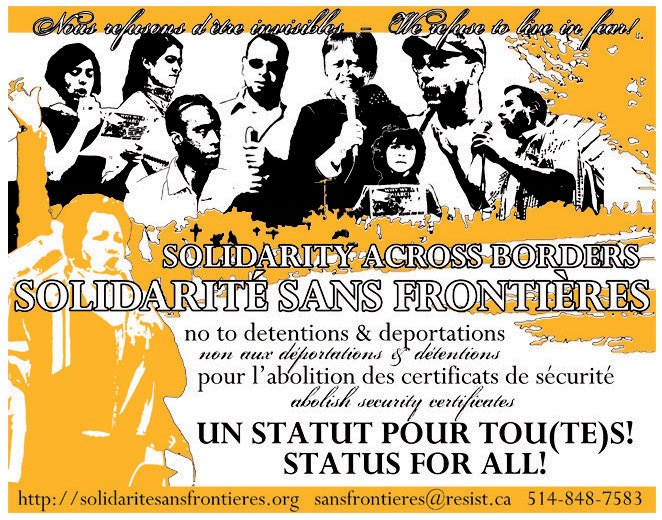By Pablo Morales
http://www.nacla.org/art_display.php?art=2707
The last time NACLA devoted a report to immigration (“Welcome to America: The Immigration Backlash,” November/December 1995), we noted: “The roots of the backlash are essentially twofold: economic uncertainty and uneasiness about the country’s changing demographics.” While the themes of economic fear and nativism persist, today’s immigration battle is powerfully conditioned by two new factors: a boom in immigration, largely from Mexico, and the post-9/11 securitization of U.S. society.
The undocumented population has not only doubled since 1996 (reaching today’s estimated 12 million), but it has dispersed throughout the United States, providing cheap labor to a variety of industries. And as a few authors in this Report note, the September 11 attacks renewed the U.S.-Mexico border as a site of crisis in the popular imaginary. With the governors of Arizona and New Mexico having declared states of emergency on their borders, this sense of urgency has largely served to designate undocumented immigrants as a national security threat, with “Secure our borders!” as the rallying cry.
A first step in understanding the conflict lies in analyzing the anti-immigration movement itself. As Solana Larsen shows, this movement is a complex, decentralized web of think tanks, foundations, political action committees, politicians, media personalities, and grassroots groups. It spans both private and public power, from the white supremacist fringe to the halls of Congress. It not only musters popular support and helps to foster a general anti-immigrant climate, but it also raises millions of dollars to advance its policy goals (curtailing immigration, deporting the undocumented) in Washington.
The Minutemen vigilantes patrolling the border see themselves as fulfilling a duty that the U.S. government has failed to execute. Yet, as Forrest Wilder reports, immigration authorities have launched a major crackdown, arresting undocumented people, including families with children, and jailing them indefinitely. This has ramped up demand for facilities, giving rise to a nationwide “detention archipelago”—a series of detention centers largely run for profit by companies contracted by the government.
Anti-immigrant activists have also targeted urban day laborers, most of them Latino immigrants, as they congregate on street corners or at stores like Home Depot looking for construction work. Besides suffering violent attacks, employer abuses, and harassment, day laborers are portrayed as job-stealing criminals. Drawing on a national survey of day laborers, Abel Valenzuela Jr. demolishes five of the most pernicious myths about them and discusses the National Day Laborer Organizing Network’s successes in protecting these workers’ rights.
Day laborers’ activism is but one example of the labor movement’s revitalization through recruiting immigrants. As home to more undocumented immigrants than any other state, California, argues Ruth Milkman, has led the way. The groundswell of anti–Proposition 187 activism in the 1990s, together with a unionizing push, built the momentum that gave us last year’s mass mobilizations—in which millions of immigrants and their supporters took to the streets to denounce the now derailed Sensenbrenner bill.
With a wave of naturalizations and impressive turnout at the November 2006 midterm elections, the national Latino-labor vote may be poised to effect real change.
Finally, the immigration debate has spotlighted tensions between African American and Latino communities. Lost in the rancor are the voices of longtime community leaders who insist harmony is possible. Rene P. Ciria-Cruz gives us a close look at South Los Angeles—a formerly majority black district transformed in a decade by Latino immigration—and spotlights the key role these leaders and old-fashioned community organizing have played in resolving conflicts and building unity.
This Report thus intervenes in the immigration debate at a critical point. As we go to print, the STRIVE Act has been unveiled in Congress as a potential compromise between liberals and conservatives. It would provide a qualified citizenship path to the undocumented, institute a temporary worker program, and intensify border enforcement.
This being as “progressive” as an immigration bill gets in Washington these days, it’s clear that the struggle for comprehensive change in U.S. policy is far from over. We hope this Report provides the information and analysis that pro-immigrant stakeholders in this debate need to keep up the fight.
skip to main |
skip to sidebar
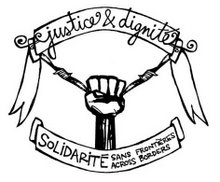



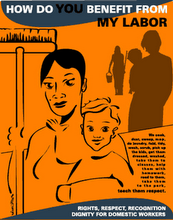

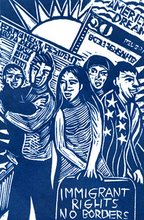


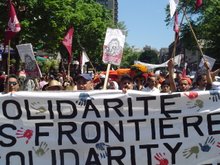







Blog Archive
-
▼
2007
(540)
-
▼
May
(71)
- Community Delegation Accompanies Sri Lankan Man Fa...
- The fight against deportations: The new sanctuary ...
- Bill has politics written all over it
- Le Code du travail s'applique aux ouvriers agricol...
- Opposition raps Tories over proposed crackdown on ...
- Ottawa veut interdire les effeuilleuses étrangères
- Case of the phony weddings
- No-fly lists provide false sense of security TheSt...
- U.S. looks north on immigration
- Grief, and Mystery, Over Immigrant’s Killing
- Terror suspect cannot be deported
- Migrants land on Canary Islands
- Video: Travailleurs agricoles
- CN Rail sues Ontario Mohawk protesters
- Railways and Colonialism
- CLASS ACTION LAWSUIT FILED FOR MAY DAY RALLY
- Canadians lining up to join spy agency
- U.S. deserters plan Supreme Court bid
- Provocative UN refugee ads target the affluent
- OF MIGRANTS AND MINUTEMEN: INSIDE THE IMMIGRATION ...
- Unions and New Immigrants
- THE ANTI-IMMIGRATION MOVEMENT: FROM SHOVELS TO SUITS
- Déportation de Mohamed Harkat
- Ruling delays review of terror suspect's deportati...
- Communiqué: Le personnel du "Guantanamo North" aff...
- Press Release: "Guantanamo North" Staff Warns Hung...
- POURQUOI NOUS MARCHONS ...
- WHY WE ARE MARCHING ...
- Marche de solidarité avec les clandestins
- Se syndiquer pour se faire respecter
- Marche pour les libertés civiles à Montréal
- Protesters march for refugees, migrants
- Demonstrators demand status for migrants
- Protesters rally against deportation of refugees
- Refugee backlog has doubled since 2006
- Video of Police attacks of NYC & LA May Day Immigr...
- Many Detainees at Guantánamo Rebuff Lawyers
- A Family Separated After the Bedford Raids
- Torn From Parents, a Top Speller Vents His Anger
- Action by Police at Rally Troubles Los Angeles Chief
- O.P.P. Set Sights on Mohawk Spokesman
- Les employeurs ouverts à l'accommodement raisonnable?
- La culture québécoise se questionne
- Mexican and Filipino migrant workers criticize Can...
- U.S and Canada wide mobilizations declare "Immigra...
- Mobilisations au Canada et aux États-Unis : immigr...
- US May Day Mobilization Coverage
- Video: Maher Arar
- Two dead, four injured in roof collapse at job sit...
- NOII-Van Shuts Down Immigration Offices
- San Antonio: Student Protestors Shout Down Minutem...
- Los Angeles Port Truckers Mobilizing for May Day S...
- US 'wants British Pakistanis to have entry visas'
- May Day Radio
- Call for Support Ojibway Warrior Society
- Sleepwalking into a surveillance state
- Rescued migrants are bound for Senegal on board a ...
- An illegal immigrant who was evacuated to the Cana...
- Britain Denies Gay Iranian's Asylum Request
- LAPD attack thousands of peaceful protestors at Im...
- As Deportation Pace Rises, Illegal Immigrants Dig In
- Statisctics Canada Reports
- Refugee claim backlog soars in first quarter
- UK terror suspects win key ruling
- Big hurdles for women: Study
- Standing Committee Report: Detention and Security ...
- Charkaoui calls for inquiry into his terrorism case
- Difficult to find job in own field, immigrants say
- Agency's launch delayed
- Sponsors balk at paying
- Commons committee to hold hearings on deporting of...
-
▼
May
(71)


Qui sommes nous:
Solidarité sans frontières est un réseau basé à Montréal qui lutte en faveur de la justice et de la dignité pour tou-te-s les sans-statut. Nous sommes un regroupement de migrant-e-s, d'immigrant-e-s, réfugié-e-s et leurs allié-e-s. Nous mobilisons pour toutes ceux et celles qui se battent contre la déportation, la détention et les certificats de sécurité.
About us:
Solidarity Across Borders is a Montreal-based network of migrants, immigrants, refugees, and allies engaged in the struggle for justice and dignity for migrants and refugees. We mobilize for all who are caught in the immigration regime and for all who fight against deportations, detentions, and security certificates.


Labels:
- War on Terrorism/Guerre contre le terrorisme (81)
- Fortress North America (64)
- Secret Trials/Proces Secret (58)
- Exploitation: Immigrant Workers/Travailleurs-EUSES immigrantEs (45)
- Migrant Resistance (37)
- Sanctuaire/Sanctuary (35)
- Detention (31)
- "Reasonable" Accomodation (30)
- Deportation (29)
- Fortress Europe (26)
- Racism (22)
- Indigenous Resistance (15)
- Propaganda (14)
- Police Harrasment/Harcelement policiere (10)
- Racial Profiling/Profilage Racial (10)
- Guantanamo (6)
- Anti-racism/Contre le racisme (4)
- Palestian Refugees/RéfugiéEs PalestinienNEs (4)
- Solidarity Across Borders (4)
- Solidarité sans frontières (4)
- Don't Ask Don't Tell (3)
- unionization/syndicalisation (3)
- Guantanamo North (2)
- LGBTQ (2)
- Labour (2)
- People's Commission (2)
- Police State/Etat policier (2)
- White Supremacy (2)
- Women (2)
- Raids (1)


Info:
(514) 848-7583
sansfrontieres[at]resist.ca
www.solidarityacrossborders.org

Contributors


Links:




